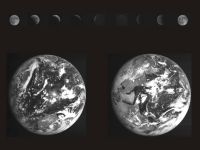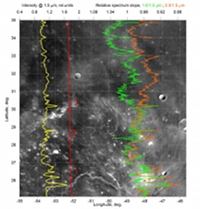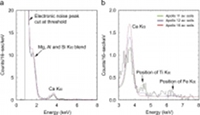ESA shares SMART-1 legacy with the world
21 September 2010
The complete archive of data sets from ESA's 3-year SMART-1 mission to the Moon has been released to the scientific community. Contained within the archive are 3D maps of the lunar poles along with detailed spectroscopic measurements of the lunar surface. Researchers can utilise this information, and cross-reference it with the wider Planetary Science Archive, to further investigate the formation and evolution of our nearest neighbour in space.
|
Access the SMART-1 science archive |
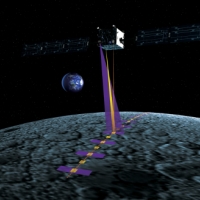 |
|
SMART-1 mapping the Moon. |
However, despite the focus on technology of the mission, SMART-1 also carried three scientific instruments for lunar study: an ultra-compact electronic camera to survey the lunar terrain in visible and near-infrared light (AMIE); an infrared spectrometer to analyse the Moon's minerals (SIR); and an X-ray spectrometer to identify key chemical elements in the lunar surface (D-CIXS). "SMART-1 was primarily a technology demonstrator mission but we also wanted to address some new scientific measurement opportunities," explained SMART-1 Project Scientist, Bernard Foing. "For example, SIR was the first infrared spectrometer ever flown around the Moon," he added.
AMIE (Advanced Moon micro-Imager Experiment) took images over the whole Moon. For the lunar south polar region, from a height of 400 km, it built up a detailed mosaic at a resolution of 40 metres per pixel. The images, which show all permutations of illumination conditions, were later combined to construct three dimensional maps of the Moon's south pole. From these studies researchers were able to identify a 'Peak of Quasi-Eternal Sunlight', located 7km from the rim of the Shackleton crater, an area of maximum illumination that could be used as the location of solar panels to power future lunar bases.
SIR (SMART-1 InfraRed Spectrometer), operating in the 0.9 – 2.6 μm wavelength range, surveyed the lunar crust with sufficient resolution to separate the signatures of pyroxene and olivine. These two minerals sank to the bottom of the ancient lunar magma ocean as it crystallised, forming the Moon's mantle. Normally the mantle is shielded from view by the lunar crust but this isn't the case where an asteroid impact has excavated the surface. SIR was able to detect pyroxene and olivine on central peaks, walls, rims and ejecta blankets of large craters, allowing measurements of the composition of the sub-surface. "Olivine occurs mostly in igneous rock, so knowing its abundance allows you to trace lunar magma that erupted violently during volcanic episodes or was stopped and cooled slowly below the surface," said Foing.
The third instrument, D-CIXS (Demonstration of a Compact Imaging X-ray Spectrometer), performed the first global mapping of X-ray fluorescence from the lunar surface in the 0.5 – 10 keV range. Light from the Sun excites the atoms on the lunar surface, with each element producing X-rays of a precise energy which D-CIXS then detected. Such data allowed an estimation of the bulk abundances of the elements Al, Mg and Si, information which has a direct bearing on the Giant Impact Theory of the Moon originating from the Earth. "Having a bulk inventory of the composition of the Moon means you can compare it to the composition of the Earth. You can then see how much of the ejected Earth, and how much of the impactor, created the debris that is thought to have re-accreted to form the Moon," Foing explained.
However, whilst normal levels of X-ray sunlight are able to excite these lighter elements, it is insufficient to excite the heavier elements needed for a full inventory. Yet as SMART-1 was orbiting the Moon at a time of high solar activity this problem was overcome; solar flares provided the necessary energy to probe the lunar surface further. A flare on the 15 January 2005 provided SMART-1 with the first ever detection of calcium from lunar orbit and observations from two subsequent flares facilitated the first detection of titanium on the Moon.
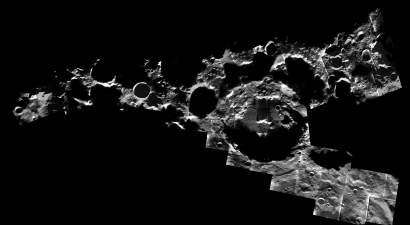 |
|
SMART-1/AMIE mosaic of the lunar South Pole. |
Having been a guinea-pig for new space mission technology and helping to unlock the secrets of the Moon's history, the SMART-1 mission came to an end in September 2006 when the spacecraft made a pre-planned and controlled impact with the Moon's Lacus Excellentiae region. In the ensuing years the data have been calibrated and collated and are now being made available to the scientific community as part of the Planetary Science Archive (PSA), which contains data sets from all the Agency's planetary missions including Rosetta and Venus Express. "The Planetary Data System (PDS) standard has been used by ESA and NASA for all of their planetary missions for more than 20 years. By standardising the way in which data are archived, we also standardise the way in which they can be read, visualised and analysed, with obvious benefits to the user," said ESA Science Archives Coordinator, David Heather.
The release of the SMART-1 archive provides an opportunity for a fresh look at the data. One aspect that has not yet been fully exploited is analysis of the catalogue of lunar images. These images have been acquired under a very broad range of illumination conditions because of the way that the lunar surface scatters sunlight differently at different angles. "The size distribution of particles in the lunar regolith influences the quantity of light reflected in a particular direction: if you look from above, or from a low angle, you will measure a different brightness," explained Detlef Koschny, who is responsible for the SMART-1 archive. By measuring these brightness differences researchers will be able to assess the size of the particles responsible; small particles imply greater fragmentation, which in turn suggests an older surface. This work can be enhanced when data from the SMART-1 archive is combined with results from other lunar missions. "Adding SMART-1 data to Chandrayaan-1 and Clementine data provides a very nice coverage of the Moon which is suitable for this type of work. That is one way in which this archive can be used," Koschny added.
Contacts:
Detlef Koschny, SMART-1 Archive Manager
Research and Scientific Support Department
Directorate of Science and Robotic Exploration, ESA
Email: Detlef.Koschny esa.int
esa.int
Phone: +31 71 565 4828
Bernard Foing, SMART-1 Project Scientist
Research and Scientific Support Department
Directorate of Science and Robotic Exploration, ESA
Email: Bernard.Foing esa.int
esa.int
Phone: +31 71 565 5647
David Heather, Science Archives Coordinator
Science Operations Department
Directorate of Science and Robotic Exploration, ESA
Email:dheather rssd.esa.int
rssd.esa.int
Phone: +31 71 565 3388

